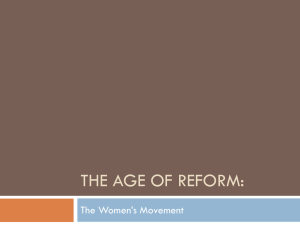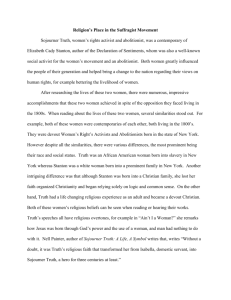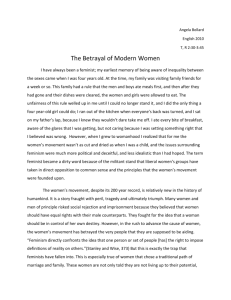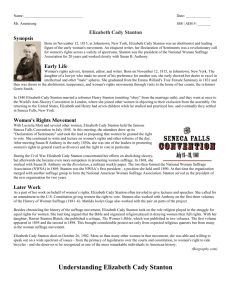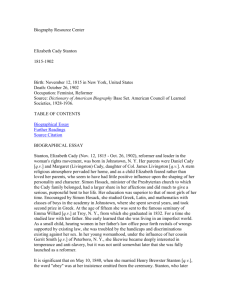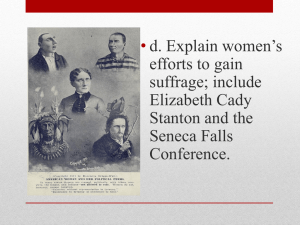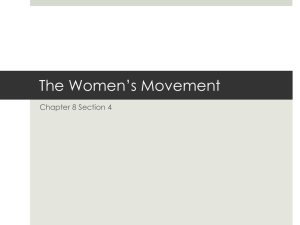74.04 KB - EngageNY
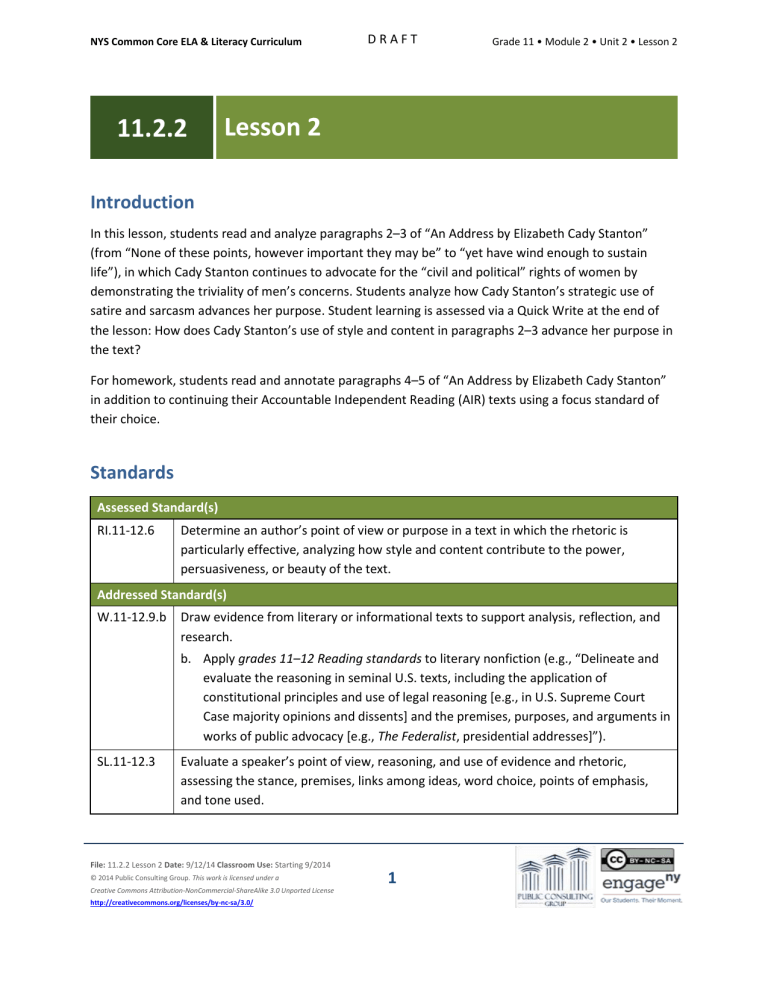
NYS Common Core ELA & Literacy Curriculum
11.2.2 Lesson 2
D R A F T
Grade 11 • Module 2 • Unit 2 • Lesson 2
Introduction
In this lesson, students read and analyze paragraphs 2–3 of “An Address by Elizabeth Cady Stanton”
(from “None of these points, however important they may be” to “yet have wind enough to sustain life”), in which Cady Stanton continues to advocate for the “civil and political” rights of women by demonstrating the triviality of men’s concerns. Students analyze how Cady Stanton’s strategic use of satire and sarcasm advances her purpose. Student learning is assessed via a Quick Write at the end of the lesson: How does Cady Stanton’s use of style and content in paragraphs 2–3 advance her purpose in the text?
For homework, students read and annotate paragraphs 4–5 of “An Address by Elizabeth Cady Stanton” in addition to continuing their Accountable Independent Reading (AIR) texts using a focus standard of their choice.
Standards
Assessed Standard(s)
RI.11-12.6 Determine an author’s point of view or purpose in a text in which the rhetoric is particularly effective, analyzing how style and content contribute to the power, persuasiveness, or beauty of the text.
Addressed Standard(s)
W.11-12.9.b Draw evidence from literary or informational texts to support analysis, reflection, and research. b.
Apply grades 11–12 Reading standards to literary nonfiction (e.g., “Delineate and evaluate the reasoning in seminal U.S. texts, including the application of constitutional principles and use of legal reasoning [e.g., in U.S. Supreme Court
Case majority opinions and dissents] and the premises, purposes, and arguments in works of public advocacy [e.g., The Federalist, presidential addresses]”).
SL.11-12.3 Evaluate a speaker’s point of view, reasoning, and use of evidence and rhetoric, assessing the stance, premises, links among ideas, word choice, points of emphasis, and tone used.
File: 11.2.2 Lesson 2 Date: 9/12/14 Classroom Use: Starting 9/2014
© 2014 Public Consulting Group. This work is licensed under a
Creative Commons Attribution-NonCommercial-ShareAlike 3.0 Unported License http://creativecommons.org/licenses/by-nc-sa/3.0/
1
NYS Common Core ELA & Literacy Curriculum
D R A F T
Grade 11 • Module 2 • Unit 2 • Lesson 2
L.11-12.4.a Determine or clarify the meaning of unknown and multiple-meaning words and phrases based on grades 11–12 reading and content, choosing flexibly from a range of strategies.
a.
Use context (e.g., the overall meaning of a sentence, paragraph, or text; a word's position or function in a sentence) as a clue to the meaning of a word or phrase.
Assessment
Assessment(s)
Student learning is assessed via a Quick Write at the end of the lesson. Students answer the following prompt, citing textual evidence to support analysis and inferences drawn from the text.
How does Cady Stanton’s use of style and content in paragraphs 2–3 advance her purpose in the text?
High Performance Response(s)
A High Performance Response should:
Identify stylistic choices Cady Stanton makes in paragraphs 2–3 (e.g., Cady Stanton uses sarcasm to imply that issues considered “important … by leading men” are insignificant in reality and will not “be touched” (par. 2) by the women at the convention. She uses satire to suggest that men’s
“philosophical experiments” (par. 3) with clothing are irrelevant to the serious issues of the convention.).
Identify content choices Cady Stanton makes in paragraphs 2–3 (e.g., Cady Stanton illustrates that despite men’s “contempt” for women’s clothing, “[m]any of the nobler sex seem to agree” with women about the superiority of female attire (par. 2). She also reinforces that women have no interest in discussions of fashion and will not “molest” men in their “philosophical experiments” with it (par. 3).).
Analyze how style and content in paragraphs 2–3 advance Cady Stanton’s purpose in the text
(e.g., Cady Stanton uses humor to explain that women “admire” (par.2) their own clothing and, unlike men, are not interested in trivial discussions related to fashion or “social life,” but instead want to discuss important matters, specifically [their] “rights” par. 1).).
Vocabulary
Vocabulary to provide directly (will not include extended instruction)
notwithstanding (conjunction) – in spite of the fact that
File: 11.2.2 Lesson 2 Date: 9/12/14 Classroom Use: Starting 9/2014
© 2014 Public Consulting Group. This work is licensed under a
Creative Commons Attribution-NonCommercial-ShareAlike 3.0 Unported License http://creativecommons.org/licenses/by-nc-sa/3.0/
2
NYS Common Core ELA & Literacy Curriculum
D R A F T
Grade 11 • Module 2 • Unit 2 • Lesson 2
barristers (n.) – (in England) lawyers who are members of one of the Inns of Court and who have the privilege of pleading in the higher courts
lord mayors (n.) – (chiefly in Britain and the Commonwealth) mayors of certain cities or the chief municipal officers of certain boroughs
imposing (adj.) – very impressive because of great size, stately appearance, dignity, elegance, etc.
philosophical (adj.) – pertaining to philosophy (the study of ideas about knowledge, truth, and the nature and meaning of life)
molest (v.) – to bother, interfere with, or annoy
stock[s] (n.) – long, usually white neckcloth[s] wrapped around the neck, worn in the 18 th century and as part of modern riding dress
kneepan (n.) – the kneecap or patella
Vocabulary to teach (may include direct word work and/or questions)
tacitly (adj.) – understood without being openly expressed; implied
Additional vocabulary to support English Language Learners (to provide directly)
convention (n.) – a large meeting of people who come to a place for usually several days to talk about their shared work or other interests or to make decisions as a group
imitating (v.) – copying (someone’s or something’s behavior, sound, appearance, etc.)
violation (n.) – the act of doing something that is not allowed by a law or rule
principle (n.) – a moral rule or belief that helps you know what is right and wrong and that influences your actions
taste (n.) – the feelings that each person has about what is appealing, attractive, etc.; the feelings that cause someone to like or not like something
dignity (n.) – the quality of being worthy of honor or respect
garments (n.) – articles of clothing
Lesson Agenda/Overview
Student-Facing Agenda
Standards & Text:
Standards: RI.11-12.6, W11-12.9.b, SL.11-12.3, L.11-12.4.a
Text: “An Address by Elizabeth Cady Stanton,” paragraphs 2–3 (Masterful
Reading: paragraphs 1–3)
File: 11.2.2 Lesson 2 Date: 9/12/14 Classroom Use: Starting 9/2014
© 2014 Public Consulting Group. This work is licensed under a
Creative Commons Attribution-NonCommercial-ShareAlike 3.0 Unported License http://creativecommons.org/licenses/by-nc-sa/3.0/
3
% of Lesson
NYS Common Core ELA & Literacy Curriculum
D R A F T
Grade 11 • Module 2 • Unit 2 • Lesson 2
Learning Sequence:
1.
Introduction of Lesson Agenda
2.
Homework Accountability
3.
Masterful Reading
4.
Reading and Discussion
5.
Quick Write
6.
Closing
4
1.
5%
2.
10%
3.
5%
4.
65%
5.
10%
6.
5%
Materials
Student copies of the Rhetorical Impact Tracking Tool (refer to 11.2.1 Lesson 6)—students may need additional blank copies
Student copies of the Short Response Rubric and Checklist (refer to 11.2.1 Lesson 1)
Consider providing blank copies of the Rhetorical Impact Tracking Tool since this is a new text in the module.
Learning Sequence
How to Use the Learning Sequence
Symbol Type of Text & Interpretation of the Symbol
10% Percentage indicates the percentage of lesson time each activity should take.
Plain text indicates teacher action. no symbol
Bold text indicates questions for the teacher to ask students.
Italicized text indicates a vocabulary word.
Indicates student action(s).
Indicates possible student response(s) to teacher questions.
Indicates instructional notes for the teacher.
Activity 1: Introduction of Lesson Agenda 5%
File: 11.2.2 Lesson 2 Date: 9/12/14 Classroom Use: Starting 9/2014
© 2014 Public Consulting Group. This work is licensed under a
Creative Commons Attribution-NonCommercial-ShareAlike 3.0 Unported License http://creativecommons.org/licenses/by-nc-sa/3.0/
NYS Common Core ELA & Literacy Curriculum
D R A F T
Grade 11 • Module 2 • Unit 2 • Lesson 2
Begin by reviewing the agenda and assessed standard for this lesson: RI.11-12.6. In this lesson, students analyze paragraphs 2–3 of “An Address by Elizabeth Cady Stanton,” paying particular attention to how
Cady Stanton’s use of style and content advance her purpose in the speech.
Students look at the agenda.
Remind students of their work with RI.11-12.6 in 11.2.2 Lesson 1, in which they determined how
Cady Stanton began to establish her purpose in paragraph 1.
Activity 2: Homework Accountability 10%
Instruct students to take out their homework from the previous lesson. (Preview and annotate paragraphs 2–3 of “An Address by Elizabeth Cady Stanton.” Box any unfamiliar words from paragraphs
2–3 and look up their definitions. Choose the definition that makes the most sense in context, and write a brief definition above or near the word in the text.)
Instruct student to form pairs and discuss their annotations for paragraphs 2–3 of “An Address by
Elizabeth Cady Stanton.”
Student responses may include: o Boxes around “leading men,” “costume,” and “nobler sex” because these words used individually are familiar, but the words used in this context are not (par.2). o A star by “male attire is neither dignified nor imposing” (par. 2) and “[y]ours be the glory to discover, by personal experience” (par. 3), because both of these statements seem to use strong language and may signify important ideas in the text. o Question marks by “philosophical experiments with stocks, pants, high-heeled boots, and
Russian belts” (par. 3), because it is unclear what the author means by “philosophical experiments” with pants or boots. It is also unclear what is meant by “stocks” and “Russian belts.”
This annotation supports students’ engagement with W.11-12.9.b, which addresses the use of textual evidence in writing.
Have students share any vocabulary words they identified and defined in the previous lesson’s homework.
Students may identify the following words: notwithstanding, barristers, lord mayors, imposing,
philosophical, molest, stocks, kneepan.
Definitions are provided in the Vocabulary box of this lesson.
File: 11.2.2 Lesson 2 Date: 9/12/14 Classroom Use: Starting 9/2014
© 2014 Public Consulting Group. This work is licensed under a
Creative Commons Attribution-NonCommercial-ShareAlike 3.0 Unported License http://creativecommons.org/licenses/by-nc-sa/3.0/
5
NYS Common Core ELA & Literacy Curriculum
D R A F T
Grade 11 • Module 2 • Unit 2 • Lesson 2
Activity 3: Masterful Reading
Instruct students to listen to a masterful reading of paragraphs 1–3 of “An Address by Elizabeth Cady
Stanton” (from “We have met here today to discuss our rights and wrongs” through “yet have wind enough left to sustain life”).
Differentiation Consideration: Consider posting or projecting the following guiding question to support students throughout the lesson:
5%
How does Cady Stanton describe women’s clothing compared to men’s clothing?
Students follow along, reading silently
Activity 4: Reading and Discussion 65%
Distribute blank copies of the Rhetorical Impact Tracking Tool, and instruct students to take notes on the tool when rhetoric is discussed in the lesson. Remind students of their work with this tool in 11.2.1.
Remind students that, as in 11.2.1, they will fill out the Purpose and Point of View sections of their
Rhetorical Impact Tracking Tools once they have analyzed Cady Stanton’s speech in its entirety.
Students listen.
Instruct students to form pairs. Post or project each set of questions below for students to discuss.
Instruct student pairs to read the first part of paragraph 2 (from “None of these points, however important they may be” to “consider our costume far more artistic than theirs”) and discuss the following questions before sharing out with the class.
Differentiation Consideration: Consider providing students with the following definitions:
convention means “a large meeting of people who come to a place for usually several days to talk about their shared work or other interests or to make decisions as a group,” imitating means
“copying (someone’s or something’s behavior, sound, appearance, etc.),” violation means “the act of doing something that is not allowed by a law or rule,” principle means “a moral rule or belief that helps you know what is right and wrong and that influences your actions,” taste means “the feelings that each person has about what is appealing, attractive, etc.; the feelings that cause someone to like or not like something,” dignity means “the quality of being worthy of honor or respect,” and
garments mean “articles of clothing.”
Students write the definitions of convention, imitating, violation, principle, taste, dignity, and
garments on their copies of the text or in a vocabulary journal.
What “points” will not “be touched in this convention”?
File: 11.2.2 Lesson 2 Date: 9/12/14 Classroom Use: Starting 9/2014
© 2014 Public Consulting Group. This work is licensed under a
Creative Commons Attribution-NonCommercial-ShareAlike 3.0 Unported License http://creativecommons.org/licenses/by-nc-sa/3.0/
6
NYS Common Core ELA & Literacy Curriculum
D R A F T
Grade 11 • Module 2 • Unit 2 • Lesson 2
Student responses may include: o Cady Stanton refers to the “points” (par. 2) she makes in the first paragraph, explaining the
“social” ideas that will not be “discuss[ed]” in her speech (par. 1). o She does not plan to discuss how “to make … husbands just, generous, and courteous,” or discuss marital/relationship issues. o She does not plan to discuss how to make men caregivers for children, “seat[ed] … at the head of a cradle” or how to “clothe every woman in male attire” by discussing clothing (par.
1). o She does not want to discuss any points that have to do with social issues concerning men and women.
How does the phrase “however important they may be considered by leading men” relate to the purpose of Cady’s Stanton’s speech?
These issues are really not “important” (par. 2) components of the jobs of “leading men” (par.1).
Cady Stanton emphasizes how discussions of marriage, childcare, and fashion are also insignificant to the purpose of her speech.
Explain to students that this phrase is an example of sarcasm. Inform students that sarcasm is a stylistic choice used to communicate ideas through the intentional misuse of words. Provide the following definition: sarcasm means “the use of words that mean the opposite of what you really want to say, especially in order to insult someone, to show irritation, or to be funny.” Instruct students to add sarcasm and its definition to their Rhetorical Impact Tracking Tools.
Students listen and write the example and definition of sarcasm on their Rhetorical Impact
Tracking Tools.
What do gentlemen need not “fear?”
According to Cady Stanton, the “gentlemen need feel no fear” of women imitating their
“costume” or clothing (par. 2).
Differentiation Consideration: If students struggle with the use of “costume” in this context, consider asking the following scaffolding question:
To what does the word “costume” refer in this sentence?
“Costume” (par. 2) refers to clothing. The sentence “As to their costume, the gentlemen need feel no fear” (par. 2) is a direct reference to Cady Stanton’s statement in paragraph 1 about
“cloth[ing] every woman in male attire.”
File: 11.2.2 Lesson 2 Date: 9/12/14 Classroom Use: Starting 9/2014
© 2014 Public Consulting Group. This work is licensed under a
Creative Commons Attribution-NonCommercial-ShareAlike 3.0 Unported License http://creativecommons.org/licenses/by-nc-sa/3.0/
7
NYS Common Core ELA & Literacy Curriculum
D R A F T
Grade 11 • Module 2 • Unit 2 • Lesson 2
Consider sharing with students that this particular use of the word costume to describe clothing is an archaic, or outdated, use of the word.
How does the word “contempt” impact the tone of Cady Stanton’s discussion of clothing?
Student responses may include: o Cady Stanton’s use of the word “contempt” (par. 2) explains that men have been critical of women’s clothing, which creates a defensive tone. o Cady Stanton’s use of “contempt” (par. 2) creates a separation between men and women, creating an adversarial tone.
Consider reminding students that their evaluation of Cady Stanton’s word choice addresses SL.11-
12.3.
Differentiation Consideration: Consider asking the following question to ensure student comprehension:
How does Cady Stanton describe men’s and women’s clothing?
Cady Stanton describes men’s clothing as unattractive or a “violation of every principle of taste, beauty, and dignity” (par. 2) and women’s clothing as “loose, flowing garments” with “graceful folds” that women “admire” (par. 2).
Lead a brief whole-class discussion of student responses. Remind students to record relevant notes and ideas from this excerpt on their Rhetorical Impact Tracking Tool.
Instruct student pairs to read the rest of paragraph 2 (from “Many of the nobler sex seem to agree with us” through “male attire is neither dignified nor imposing”) and answer the following questions before sharing out with the class.
Inform students that the positions of bishop, priest, judge, barrister, lord mayor, the Pope of Rome, and cardinals were all occupied by men in Cady Stanton’s day.
Who is the “nobler sex” to whom Cady Stanton refers?
Cady Stanton refers to men when she uses the phrase “nobler sex” (par. 2). She uses examples of male-dominated roles such as “bishops, priests, judges, barristers … lord mayors … the Pope of Rome” and “his cardinals” (par. 2) to support her idea that female clothing is “far more artistic” (par. 2) than men’s.
How does Cady Stanton explain that “male attire is neither dignified nor imposing”?
File: 11.2.2 Lesson 2 Date: 9/12/14 Classroom Use: Starting 9/2014
© 2014 Public Consulting Group. This work is licensed under a
Creative Commons Attribution-NonCommercial-ShareAlike 3.0 Unported License http://creativecommons.org/licenses/by-nc-sa/3.0/
8
NYS Common Core ELA & Literacy Curriculum
D R A F T
Grade 11 • Module 2 • Unit 2 • Lesson 2
Student responses may include: o Cady Stanton states that “[m]any of the nobler sex … all wear loose flowing robes” (par. 2), which is similar to her description of women’s “loose, flowing garments” (par. 2). She reasons that the choice of powerful men to wear clothing similar to women’s is evidence of them “tacitly “acknowledging” that men’s clothing is “neither dignified nor imposing” (par.
2). o The powerful men may not come out and say women’s clothing is superior, but by wearing the same style as women, the powerful men agree that women’s clothing is “far more artistic than theirs” (par. 2).
Based on this analysis, what might the word tacitly mean?
Tacitly could mean the same as “imply.” It refers to something that may be communicated without words.
Consider drawing students’ attention to their application of standard L.11-12.4.a through the process of determining the meaning of a word through context.
How does the statement “[m]any of the nobler sex seem to agree with us” support the idea that
“gentlemen need feel no fear of our imitating”?
Cady Stanton explains that women are not interested in wearing men’s clothing because women’s clothing is better, which noble men demonstrate by wearing “loose flowing robes”
(par. 2) similar to women’s clothing.
What effect does Cady Stanton’s word choice have on the tone in this paragraph?
Student responses may include: o Cady Stanton’s description of men’s clothing as a “violation of every principle of taste, beauty, and dignity” (par. 2) creates a mocking or teasing tone by suggesting that men have no fashion sense. o Cady Stanton’s choice to describe men as the “nobler sex” (par. 2) suggests a tone of irony.
Her descriptions of men, including her implication that they are not “just, generous, and courteous” (par. 1) husbands, and that they have “contempt” (par. 2) for women’s clothing, indicates she does not truly feel men are “noble[]” (par. 2). o Cady Stanton’s use of the phrase “None of these points, however important they may be considered by leading men” (par. 2), creates a sarcastic tone because “leading men” do not typically get involved in “points” (par. 2) related to marital relationships, childcare, or clothing.
File: 11.2.2 Lesson 2 Date: 9/12/14 Classroom Use: Starting 9/2014
© 2014 Public Consulting Group. This work is licensed under a
Creative Commons Attribution-NonCommercial-ShareAlike 3.0 Unported License http://creativecommons.org/licenses/by-nc-sa/3.0/
9
NYS Common Core ELA & Literacy Curriculum
D R A F T
Grade 11 • Module 2 • Unit 2 • Lesson 2
Lead a brief whole-class discussion of student responses. Remind students to record relevant notes and ideas from this excerpt on their Rhetorical Impact Tracking Tools.
Instruct student pairs to read paragraph 3 (from “No, we shall not molest you in your philosophical experiments” through “yet have wind enough left to sustain life”) and answer the following questions before sharing out with the class.
What does Cady Stanton describe as “philosophical experiments”?
Cady Stanton describes men’s fashion such as “stocks, pants, high-heeled boots, and Russian belts” as “philosophical experiments” (par. 3).
What does Cady Stanton imply about men when she describes their fashion as “philosophical experiments”?
By describing men’s fashion as “philosophical experiments” (par. 3), Cady Stanton implies that men are overly concerned with the unimportant subject of fashion.
What does Cady Stanton mean when she states that women will not “molest” the men in their
“philosophical experiments” with fashion?
When Cady Stanton says that women will not “molest” men, she means that women will not bother men about details of “social life” like fashion because there are more important issues to discuss. Cady Stanton wants to leave the “glory” of fashion “discover[ies]” (par. 3) to men, while women “discuss [their] rights and wrongs, civil and political” (par. 1).
What is the effect of Cady Stanton’s use of rhetoric in the second sentence of paragraph 3?
Cady Stanton uses repetition in this sentence when she describes the effects of male fashion with statements that are phrased similarly: “how long,” “how short,” “how high,” and “how tight” (par. 3). The repetition of this structure reinforces Cady Stanton’s approach of portraying men as being concerned about a trivial issue such as fashion; it also dramatizes the extremes of their clothing trends, which implies that men are vain.
Consider reminding students that their evaluation of Cady Stanton’s use of rhetoric addresses SL.11-
12.3.
How do Cady Stanton’s comments about “the glory” of “personal experience” impact the tone of this paragraph?
File: 11.2.2 Lesson 2 Date: 9/12/14 Classroom Use: Starting 9/2014
© 2014 Public Consulting Group. This work is licensed under a
Creative Commons Attribution-NonCommercial-ShareAlike 3.0 Unported License http://creativecommons.org/licenses/by-nc-sa/3.0/
10
NYS Common Core ELA & Literacy Curriculum
D R A F T
Grade 11 • Module 2 • Unit 2 • Lesson 2
Cady Stanton uses a sarcastic tone to suggest that men should discover for themselves how uncomfortable “the kneepan … the stock … the heel of a boot … and … the Russian belt” (par. 3) can be.
Consider reminding students that their evaluation of Cady Stanton’s tone addresses SL.11-12.3.
How does Cady Stanton’s tone contribute to the persuasiveness of this paragraph?
Cady Stanton uses a sarcastic and humorous tone in this paragraph to show that contrary to what “some have supposed” (par. 1), men make sillier fashion choices than women. Therefore, women have no desire to imitate men in their clothing. This establishes fashion and other details of social life as irrelevant to the issue at hand, and helps to persuade the reader to instead consider the importance of the “civil and political” (par. 1) rights of women, rather than the trivial issues of “social life” (par. 1).
Explain to students that satire means “the use of humor, sarcasm, irony or exaggeration to expose the weakness or bad qualities of a person, government, society, etc.” Satirical writing can be used to achieve a rhetorical effect like persuasion. Cady Stanton’s approach in this paragraph is satirical because she uses humor and exaggeration to expose that, contrary to popular belief, men are frivolous and silly about their clothes. Instruct students to add satire and its definition to their Rhetorical Impact Tracking
Tools.
Students listen and add the example and definition of satire to their Rhetorical Impact Tracking
Tools.
Lead a brief whole-class discussion of student responses. Remind students to record relevant notes and ideas from this excerpt on their Rhetorical Impact Tracking Tool.
Activity 5: Quick Write 10%
Instruct students to respond briefly in writing to the following prompt:
How does Cady Stanton’s use of style and content in paragraphs 2–3 advance her purpose in the text?
Instruct students to look at their annotations to find evidence. Ask students to use this lesson’s vocabulary wherever possible in their written responses. Remind students to use the Short Response
Rubric and Checklist to guide their written responses.
Students listen and read the Quick Write prompt
Display the prompt for students to see, or provide the prompt in hard copy.
Transition to the independent Quick Write.
File: 11.2.2 Lesson 2 Date: 9/12/14 Classroom Use: Starting 9/2014
© 2014 Public Consulting Group. This work is licensed under a
Creative Commons Attribution-NonCommercial-ShareAlike 3.0 Unported License http://creativecommons.org/licenses/by-nc-sa/3.0/
11
NYS Common Core ELA & Literacy Curriculum
D R A F T
Grade 11 • Module 2 • Unit 2 • Lesson 2
Students independently answer the prompt using evidence from the text.
See the High Performance Response at the beginning of this lesson.
Activity 6: Closing 5%
Display and distribute the homework assignment. For homework, instruct students to read and annotate paragraphs 4–5 of “An Address by Elizabeth Cady Stanton” (from “But we are assembled to protest against a form of government” to “however they may differ in mind, body, or estate.”)
Also for homework, instruct students to continue to read their AIR texts through the lens of a focus standard of their choice and prepare for a 3–5 minute discussion of their text based on that standard.
Students follow along.
Homework
For homework, preview and annotate paragraphs 4–5 of “An Address by Elizabeth Cady Stanton” (from
“But we are assembled to protest against a form of government” to “however they may differ in mind, body, or estate”).
Also, continue to read your Accountable Independent Reading text through the lens of a focus standard of your choice and prepare for a 3–5 minute discussion of your text based on that standard.
File: 11.2.2 Lesson 2 Date: 9/12/14 Classroom Use: Starting 9/2014
© 2014 Public Consulting Group. This work is licensed under a
Creative Commons Attribution-NonCommercial-ShareAlike 3.0 Unported License http://creativecommons.org/licenses/by-nc-sa/3.0/
12
NYS Common Core ELA & Literacy Curriculum
D R A F T
Grade 11 • Module 2 • Unit 2 • Lesson 2
Model Rhetorical Impact Tracking Tool
Name: Class: Date:
Directions: Use this tool to track the rhetorical devices you encounter in the text, as well as examples of these devices and their definitions. Be sure to note the rhetorical effect of each device in the text.
Text: “An Address by Elizabeth Cady Stanton”
RI.11-12.6: Determine an author’s point of view or purpose in a text in which the rhetoric is particularly effective, analyzing how style and content contribute to the power, persuasiveness, or beauty of the text.
Rhetoric: the specific techniques that writers or speakers use to create meaning in a text, enhance a text or a speech, and in particular, persuade readers or listeners
Point of View (an author’s opinion, attitude, or judgment):
Purpose (an author’s reason for writing):
Rhetorical device and definition
Examples of the rhetorical device in the text (with paragraph or page reference)
Rhetorical Effect (power, persuasiveness, beauty, point of view, purpose)
Sarcasm: the use of words that mean the opposite of what you really want to say, especially in order to insult someone, to show irritation, or to be funny
“None of these points, however important they may be considered by leading men, will be touched in this convention.” (par. 2)
Cady Stanton is using sarcasm to advance her purpose by suggesting sarcastically that “leading men” might think issues regarding social life are important to women but for the purposes of the “convention,” they are not.
File: 11.2.2 Lesson 2 Date: 9/12/14 Classroom Use: Starting 9/2014
© 2014 Public Consulting Group. This work is licensed under a
Creative Commons Attribution-NonCommercial-ShareAlike 3.0 Unported License http://creativecommons.org/licenses/by-nc-sa/3.0/
13
NYS Common Core ELA & Literacy Curriculum
Repetition: the act of saying or writing something again
D R A F T
Repetitive use of phrasing in referencing male fashion, such as “how long,” “how short,” “how high,” and “how tight.” (par. 3)
Grade 11 • Module 2 • Unit 2 • Lesson 2
The use of repetition reinforces Cady Stanton’s purpose of portraying men as being concerned about trivial items like fashion.
Satire: the use of humor, sarcasm, irony or exaggeration to expose the weakness or bad qualities of a person, government, society
“Yours be the glory to discover, by personal experience, how long the kneepan can resist the terrible strapping down which you impose, in how short time the welldeveloped muscles of the throat can be reduced to mere threads by the constant pressure of the stock.” (par. 3)
The use of satire advances Cady Stanton’s purpose of demonstrating how serious women are in discussing their rights as opposed to trivial conversations about fashion.
Cady Stanton is revealing that men often think women want to have stereotypical conversations about trivial social matters such as fashion whereas Cady Stanton is demonstrating that this is not the case and women are serious about discussing their rights.
File: 11.2.2 Lesson 2 Date: 9/12/14 Classroom Use: Starting 9/2014
© 2014 Public Consulting Group. This work is licensed under a
Creative Commons Attribution-NonCommercial-ShareAlike 3.0 Unported License http://creativecommons.org/licenses/by-nc-sa/3.0/
14
